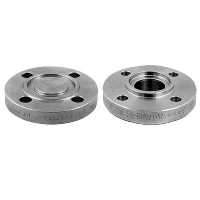Flanges play an important role in connecting pipelines. In addition to understanding the basic types of flanges, you must further understand the sealing surface forms and applications of flanges. In addition, because the specifications of flanges are very diverse, the standard classification of flanges is also something that needs to be paid attention to when selecting. Common flange standards will be introduced in the next article.
Common flange sealing surface forms and codes? Which gasket types are applicable?
- Full Flat Surface (FF)
The smooth flat surface and simple structure make it easy to process corrosion-resistant linings. Use a soft gasket to cover the entire flange sealing surface. Since the contact area between the sealing surface and the gasket is large, after pre-tightening, the gasket easily moves to both sides and is squeezed out of the sealing surface. The sealing performance is poor, so it is more suitable for Applications where pressure is low and temperatures are not high. Flange gaskets are generally divided into metal gaskets and non-metallic gaskets. The gasket materials suitable for all flat surfaces include non-asbestos rubber and other non-metallic soft gaskets.
- Raised Surface (RF)
The smooth surface and simple structure make it easy to process. It is the most widely used form because it is easy to install. The contact surface of the gasket protrudes from the circumferential connection surface surrounded by the flange bolt holes, concentrating the pressure on a smaller gasket range, thereby improving the pressure-bearing capacity. Applicable gasket materials include non-metallic covered gaskets and metal wound gaskets.
- Concave-Convex Surface (MFM)
It consists of a concave surface and a convex surface, which are used in pairs for easy alignment during installation. Placing a gasket on the concave surface can prevent the gasket from being squeezed, so it is suitable for applications with high pressure and strict sealing requirements, but it is also inconvenient to replace the gasket. However, when using a concave and convex sealing surface in a high temperature operating environment, the gasket may still be extruded. Applicable gasket materials include various non-metallic flat gaskets, non-metallic covered gaskets, metal-coated gaskets, metal wound gaskets, etc.
- Tongue and Groove Surface (TG)
It consists of a tenon surface and a groove surface. They are used in pairs and the gasket is placed in the groove. Therefore, the compression area is small, the gasket is evenly stressed and is not easily squeezed. Since the gasket is not in direct contact with the medium, the sealing effect is good and can be used in high-pressure, flammable, explosive, and toxic media. Applicable gasket materials include various metal and non-metal flat gaskets, metal-clad gaskets, metal wound gaskets, etc.
- Ring Joint Surface (RTJ)
Place the circular metal sealing ring in the annular groove without pressing the gasket into the groove. The compression area is small and the pressure of the gasket is uniform. When the bolt is tightened, the metal ring is compressed, forming a tight seal. Since the gasket is not in direct contact with the medium, it is often used in applications with strict sealing requirements, such as high temperature and high pressure, flammable, explosive, and toxic media. Applicable gaskets are octagonal or oval metal gaskets.
The above is the basic description of the flange sealing surface form. When considering the flange to be installed with the pump, it is recommended to consult with professionals before making the selection.
PTCXPUMP acid and alkali resistant sealless magnetic pump provide standard flange specifications (ANSI, JIS, DIN), adopts a three-piece movable flange design, and the position of the screw holes can be adjusted during piping installation, to avoid leakage at the entrance and exit.
The best solution for chemical fluid transportation》PTCXPUMP sealless magnetic pump / INNOMAG Lined Sealless Magnetic Pump




